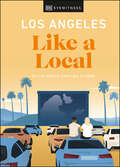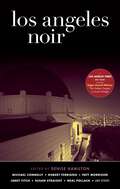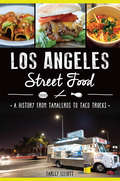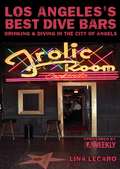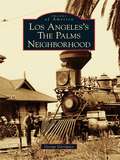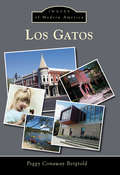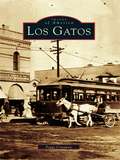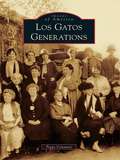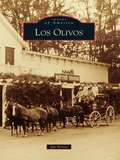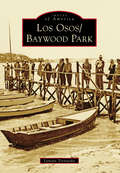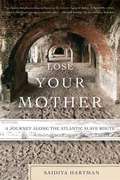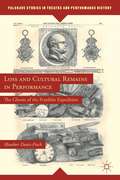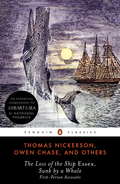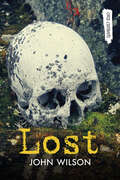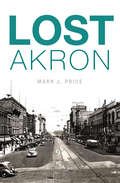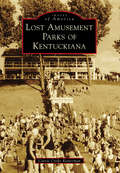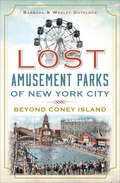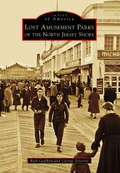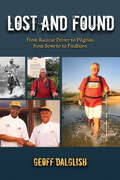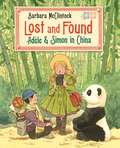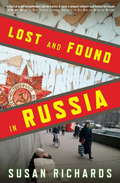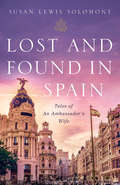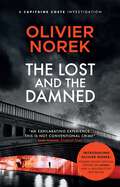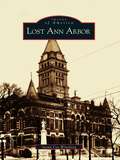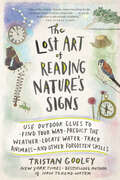- Table View
- List View
Los Angeles Like a Local: By the People Who Call It Home (Local Travel Guide)
by DK Eyewitness Sarah Bennett Ryan Gajewski Anita Little Eva RecinosKeen to explore a different side of Los Angeles? Like a Local is the book for you.This isn&’t your ordinary travel guide. You won&’t find Disneyland or the Hollywood Hills in these pages, because that&’s not where Angelenos hang out. Instead, you&’ll meet the locals at quirky museums, Mexican food trucks and hidden speakeasies– and that&’s where this book takes you. Turn the pages to discover: The small businesses and community strongholds that add character to this vibrant city, recommended by true locals.6 themed walking tours dedicated to specific experiences such as flea markets and movie theatres.A beautiful gift book for anyone seeking to explore Los Angeles. Helpful &‘what3word&’ addresses, so you can pinpoint all the listed sights.Compiled by four proud locals, this stylish travel guide is packed with Los Angeles&’ best experiences and hidden spots, handily categorized to suit your mood and needs.Whether you&’re a restless Angeleno on the hunt for a new hangout, or a visitor keen to discover a side you won&’t find in traditional guidebooks, Los Angeles Like A Local will give you all the inspiration you need. About Like A Local:These giftable and collectible guides from DK Eyewitness are compiled exclusively by locals. Whether they&’re born-and-bred or moved to study and never looked back, our experts shine a light on what it means to be a local: pride for their city, community spirit and local expertise. Like a Local will inspire readers to celebrate the secret as well as the iconic – just like the locals who call the city home. Looking for another guide to Los Angeles? Explore further with our DK Eyewitness or Top 10 guides to California.
Los Angeles Noir (Akashic Noir #0)
by Denise HamiltonMichael Connelly, Janet Fitch, Susan Straight, and others join Hamilton in digging deeper than ever before into the city's glorious noir legacy. Brand-new stories by: Michael Connelly, Janet Fitch, Susan Straight, Hector Tobar, Patt Morrison, Robert Ferrigno, Gary Phillips, Christopher Rice, Naomi Hirahara, Jim Pascoe, Scott Phillips, Diana Wagman, Lienna Silver, Brian Ascalon Roley, and Denise Hamilton. Denise Hamilton writes the Eve Diamond series. Her books have been shortlisted for the Edgar, Macavity, Anthony, and Willa Cather awards. The Los Angeles Times named Last Lullaby a Best Book of 2004, and it was also a USA Today Summer Pick and a finalist for a Southern California Booksellers Association 2004 award. Her fourth Eve Diamond novel, Savage Garden, is a Los Angeles Times bestseller and was shortlisted for the Southern California Booksellers Association award for Best Mystery of 2005. Akashic Books Noir Series is selling great; nearly every title has gone into multiple printings. Whole series to be promoted at major trade conferences and mystery conferences. Major media push: print, radio, television.
Los Angeles Street Food: A History from Tamaleros to Taco Trucks (American Palate)
by Farley ElliottA history and guidebook for locals and visitors who want to explore the flavorful delights of the nation’s street food capital—includes photos!Los Angeles is the uncontested street food champion of the United States, and it isn’t even a fair fight. Millions of hungry locals and tourists take to the streets to eat tacos, down bacon-wrapped hot dogs, and indulge in the latest offerings from a fleet of gourmet food trucks and vendors. Dating back to the late nineteenth century when tamale men first hawked their fare from pushcarts and wagons, street food is now a billion-dollar industry in L.A.—and it isn’t going anywhere! So hit the streets and dig in with local food writer Farley Elliott, who tackles the sometimes-dicey subject of street food and serves up all there is to know about the greasy, cheesy, spicy, and everything in between.
Los Angeles's Best Dive Bars
by Lina LecaroLos Angeles might be the capital of conspicuous consumption, but the other cliché about "La La Land"-that it's a cultural wasteland-couldn't be further from the truth. For every "Extreme Makeover-Club Edition" (in which would-be impresarios continually swankify their establishments in a relentless quest to be "the" hot spot du jour), there is a well-worn drinking hole full of history, serving up a far more elusive and seductive mix of stiff drinks, loose atmosphere and keep-it-real regulars.In Los Angeles' Best Dive Bars, you'll get the scoop and the poop on the city's liveliest, lowlife n' liquor-soaked landmarks. This essential booze bible has the lowdown on which bars serve free food, which have great-and not so great-karaoke, bars that appear in your favorite movies and much, much more. Whether you're looking for a friendly spot where "everybody knows your name," a filthy blackened cave where nobody ever will, a gently-gentrified hole specked with dive-obsessed hipsters or a dusty relic full of hip-replacements, you're sure to find a spot to soak up-and get soaked in-here in these pages.LINA LECARO is the nightlife columnist for the LA Weekly. She has been patrolling Los Angeles' most decadent after dark dens and its grungiest grottos with equal aplomb for over twenty years (i.e. before she could actually drink legally). A born and bred Angeleno, she's no angel when it comes to digging deep into LA's most harrowing drunkard-approved hovels . She might prefer her cocktails sweet, but her favorite bars (and barflys) have always been anything but.
Los Angeles's The Palms Neighborhood
by George GarriguesThe Westside neighborhood of Palms is the oldest suburb of Los Angeles. Founded in 1886 halfway between L.A. and the beach on a steam railroad line, Palms attracted wealthy Angelinos escaping the summer's downtown heat as well as Easterners seeking a new life in "the natural home of the fig, olive, lemon, lime, apricot, and that class of fruit that brings the largest profit in the local market." Rancho Park and Mar Vista had yet to make it onto maps--it was all "The Palms." The school district stretched from the Santa Monica Mountains on the north toward Redondo Beach on the south. A lively social and business life sprang up, but gradually the metropolis enfolded Palms, which was annexed into Los Angeles in 1915. After World War II, subdivisions brought young families, the flatlands became a huge swath of apartments, and the barren hill area became the tree-shrouded Westside Village.
Los Gatos (Images of Modern America)
by Peggy Conaway BergtoldA magical place to grow up and an exceptionally lovely place to live, Los Gatos has transformed from its agrarian roots to an upscale community at the southern tip of Silicon Valley. With its sublime Mediterranean climate and stunning natural setting, the town has progressed while still valiantly protecting its small town character and customs. The 1989 Loma Prieta earthquake hit Los Gatos hard, creating a devastating litany of 481 damaged homes and businesses, many of them historic. Los Gatos made the decision to rebuild and restore what had been lost, with picture-perfect results.
Los Gatos
by Peggy ConawayNestled in the heart of a dramatic natural amphitheater formed by the Santa Cruz Mountains, Los Gatos serves as the gateway from the Santa Clara Valley to the Pacific Ocean. This happy accident of location allowed historic Los Gatos to witness a colorful parade of swashbuckling explorers, Franciscan padres, and hearty American pioneers, many of whom came to harvest virgin redwood forests from the mountains and grow fruit in exceptionally fertile soil. Los Gatos grew up around the 1850s flour mill established by Scotsman James Alexander Forbes. In 1878 the railroad arrived and was a powerful influence for more than 80 years. Named for the mountain lions that still inhabit the area, Los Gatos has reflected the expansive richness of the California Dream for 150 years.
Los Gatos Generations
by Peggy ConawayFrom its beginnings as a Mexican land grant, Los Gatos has been filled with promise. A beautiful natural setting attracted a fascinating population of innovators, inventors, intellectuals, and artists; those who dreamed and those who cultivated the splendid richness of the soil. A gracious integration of fruit, flowers, and a gentle, delightful climate allowed settlers to thrive and find sure success. Inevitable tragedy and troubles also beset the little settlement at the western edge of the country, especially a series of devastating fires and episodes of raw frontier violence in the 1880s. Yet through all of its history, Los Gatos has prided itself on its strong sense of community, each generation proud of its heritage and of what they accomplished. A gathering of talent graced each decade--hopeful, hardworking people who appreciated the unique combination of an ideal place and abundant opportunity existent in their corner of the "Valley of Hearts Delight."
Los Olivos
by Jim NorrisLos Olivos was named for central Santa Barbara County wine country's other small fruit. The local fascination for vineyards is fairly new, but Los Olivos has thrived as a community since not long after Native American days. Los Olivos grew important enough to local trade and travel to become the inland terminus of the narrow-gauge Pacific Coast Railway, which zigzagged southeasterly from Avila Beach. The town was platted in 1887 by the West Coast Land Company and the railroad's owners. The dry-farming of grain and cattle ranches eventually drove the local economy in the surrounding Santa Ynez River Valley. Today Los Olivos thrives as a way station and gateway for tourists enjoying the beauty of the valley, the Santa Ynez Mountains, Los Padres National Forest, and nearby attractions, including the Mission Santa Ines, wineries, Solvang, and Santa Barbara.
Los Osos/Baywood Park (Images of America)
by Lynette TornatzkyLos Osos and Baywood Park, on the south end of Morro Bay, were two independent areas that developed separately during different periods. Over time, they grew together. In 1974, the US Post Office eliminated the Baywood branch and declared the area as Los Osos. Residents, passionate about their neighborhoods, specifically refer to Cuesta-by-the-Sea, Baywood, or the 12 other housing areas, while nonresidents ascribe to the Los Osos name. This area, including the beautiful Los Osos Valley, has been home to artisans, fishermen, and hunters for centuries, and more recently, cattle ranchers and farmers. The town grew haphazardly in fits and starts. Quirky, rebellious, off the beaten path--all apply. People here are happy to be a bit undiscovered and prefer that it stays that way.
Lose Your Mother: A Journey Along the Atlantic Slave Route
by Saidiya HartmanIn Lose Your Mother, Saidiya Hartman traces the history of the Atlantic slave trade by recounting a journey she took along a slave route in Ghana. Following the trail of captives from the hinterland to the Atlantic coast, Hartman reckons with the blank slate of her own genealogy and vividly dramatizes the effects of slavery on three centuries of African and African-American history. The slave, Hartman observes, is a stranger, one torn from family, home, and country. To lose your mother is to be severed from your kin, to forget your past, and to inhabit the world as an outsider, an alien. There are no known survivors of Hartman's lineage, no relatives in Ghana whom she came hoping to find. She is a stranger in search of strangers, and this fact leads her into intimate engagements with the people she encounters along the way and draws her deeper into the heartland of slavery. She passes through the holding cells of military forts and castles, the ruins of towns and villages devastated by the trade, and the fortified settlements built to repel predatory armies and kidnappers. In artful passages of historical portraiture, she shows us an Akan prince who granted the Portuguese permission to build the first permanent trading fort in West Africa, a girl murdered aboard a slave ship, and a community of fugitives seeking a haven from slave raiders.
Loss and Cultural Remains in Performance
by Heather Davis-FischIn 1845, John Franklin's Northwest Passage expedition disappeared. The expedition left an archive of performative remains that entice one to consider the tension between material remains and memory and reflect on how substitution and surrogation work alongside mourning and melancholia as responses to loss.
The Loss Of The Ship Essex, Sunk By A Whale
by Thomas Nickerson Owen Chase Nathaniel Philbrick Thomas PhilbrickThe gripping first-hand narrative of the whaling ship disaster that inspired Melville’s Moby-Dick and informed Nathaniel Philbrick’s monumental history, In the Heart of the Sea. In 1820, the Nantucket whaleship Essex was rammed by an angry sperm whale thousands of miles from home in the South Pacific. The Essex sank, leaving twenty crew members drifting in three small open boats for ninety days. Through drastic measures, eight men survived to reveal this astonishing tale. The Narrative of the Wreck of the Whaleship Essex, by Owen Chase, has long been the essential account of the Essex’s doomed voyage. But in 1980, a new account of the disaster was discovered, penned late in life by Thomas Nickerson, who had been the fifteen-year-old cabin boy of the ship. This discovery has vastly expanded and clarified the history of an event as grandiose in its time as the Titanic. This edition presents Nickerson’s never-before-published chronicle alongside Chase’s version. Also included are the most important other contemporary accounts of the incident, Melville’s notes in his copy of the Chase narrative, and journal entries by Emerson and Thoreau. .
Lost: Books V And Vi (Orca Currents)
by John WilsonIn this high-interest novel for young readers, teen sleuths Sam and Annabel solve a mystery in the Arctic that has ties to the Franklin Expedition.
Lost Akron (Lost)
by Mark J. PriceFrom a prehistoric locale like the Big Falls of the Cuyahoga River to the cavernous 1970s majesty of the Coliseum, explore the places that have melted away in Akron's changing landscape. Remember M. O'Neil Company? Akron Times-Press? The North Hill Viaduct? WAKR-TV? Norka Soda? Rolling Acres Mall? These are icons that all defined the city and its people. For those who live in Akron, for those who have moved away and for those too young to remember the Rubber City's heyday, author Mark J. Price takes a fascinating look at fifty vanished landmarks from Akron's past.
Lost Amusement Parks of Kentuckiana (Images of America)
by Carrie Cooke KettermanThe banks of the Ohio River, where picnic grounds flourished and steamboat travel was abundant, provided an ideal location for amusement parks to thrive in Kentuckiana, a term used to describe the Louisville and southern Indiana area. Popular amusement parks such as Glenwood Park, Rose Island, White City, Fontaine Ferry, and Kiddieland welcomed visitors as early as 1902, and the more successful parks continued to operate well into the 1960s. Visitors to these parks enjoyed steamboat excursions, live music, rides, games, picnics, sporting events, and more. These parks were not only for amusement seekers but also for keen businessmen like David Rose, who purchased Fern Grove in 1923 and renamed the park Rose Island. Transportation businesses thrived, with steamboats like the Idlewild (now the Belle of Louisville) providing regular transportation to the parks along the Ohio River. In addition to an increase in river traffic, companies like the New Albany Traction Company purchased the area that would become Glenwood Park from the well-known Beharrel family, of New Albany, Indiana, and provided rail transportation to their park.
Lost Amusement Parks of New York City: Beyond Coney Island (Lost Ser.)
by Barbara Gottlock Wesley GottlockA historical tour of fun and frolic in the five boroughs—including photos from the good old days. Coney Island is an iconic symbol of turn-of-the-century New York—but many other amusement parks have thrilled the residents of the five boroughs. Strategically placed at the end of trolley lines, railways, public beaches, and waterways, these playgrounds for the rich and poor alike first appeared in 1767. From humble beginnings, they developed into huge sites like Fort George, Manhattan&’s massive amusement complex. Each park was influenced by the culture and eclectic tastes of its owners and patrons—from the wooden coasters at Staten Island&’s Midland Beach to beer gardens on Queens&’ North Beach and fireworks blasting from the Bronx&’s Starlight Park. As real estate became more valuable, these parks disappeared. With this historical tour, you can rediscover the thrills of the past from the lost amusement parks of New York City.
Lost Amusement Parks of the North Jersey Shore (Images of America)
by George Severini Rick GeffkenThe Jersey Shore has always attracted people seeking relief from summer heat and humidity. Long before Europeans came here, the native Lenape clammed, fished, and played games on the beach and in the surf. These original people could scarcely have imagined that, by the end of the 19th century, the 120-mile-long coastline of New Jersey would be dotted with amusement parks featuring gentle kiddie car rides, terrifying roller coasters, merry-go-rounds, and fast-food emporiums. James Bradley in Asbury Park and William Sandlass Jr. in Highland Beach created mass entertainment for hundreds of thousands of people. Their seaside recreation centers, along with those in Long Branch, Bradley Beach, Pleasure Bay, and others, endured for years but are just fond and fading memories today.
Lost and Found
by Geoff DalglishTackling the goal to walk 25,000 miles -the equivalent of the circumference of the planet - one man shares life-changing insights through his personal travel vignettes. Formerly a thrill-seeking journalist, Geoff Dalglish begins his impressive expedition after undergoing a spiritual and ecological awakening at the Findhorn center in Scotland. His deliberate journey from Timbuktu to Antarctica to Hollywood unfolds in vivid and inspiring detail, revealing a wealth of unimaginable experiences while sharing a message about treading lightly on the Earth. From the horrors of bloody civil unrest and death-defying moments at the hands of armed guerilla soldiers to close encounters with the animal kingdom and finding healing balm within spiritual communities, this roller coaster of adventure chronicles a deeper quest for meaning that culminates in the joys of a life lived in simplicity and service.
Lost and Found: Adèle & Simon in China (Adele & Simon)
by Barbara McClintockWhen siblings Adèle and Simon visit their uncle in China, he buys them each gifts for their trip. Simon picks out a hat, a flute, a fan, and other small items, while his sister selects a camera to photograph their journey. As soon as they're packed and ready, it's time to set off with Uncle Sydney to explore! In a series of postcards home to their mother, Adèle describes each of the places they visit and the adventures they have... and, of course, what item Simon managed to lose at each stop along the way. On a silk farm in Shanghai, he loses his scarf. Along the Great Wall, his hat blows right off his head. By the end of the trip, Simon has misplaced all of his belongings! But when Adèle develops her photographs, she and her brother discover that they can see each of Simon's lost items in the background of the pictures.Barbara McClintock's meticulous research and intricate pen-and-ink and watercolor illustrations bring this book to life, capturing the essence of each of the culturally and historically significant sites that Adèle and Simon visit. Children will love poring over the pictures to find Simon's lost items, and parents will value the authenticity of the art and story.
Lost and Found in Russia
by Susan RichardsAfter the fall of communism, Russia was in a state of shock. The sudden and dramatic change left many people adrift and uncertain--but also full of a tentative but tenacious hope. Returning again and again to the provincial hinterlands of this rapidly evolving country from 1992 to 2008, Susan Richards struck up some extraordinary friendships with people in the middle of this historical drama. Anna, a questing journalist, struggles to express her passionate spirituality within the rules of the new society. Natasha, a restless spirit, has relocated from Siberia in a bid to escape the demands of her upper-class family and her own mysterious demons. Tatiana and Misha, whose business empire has blossomed from the ashes of the Soviet Union, seem, despite their luxury, uneasy in this new world. Richards watches them grow and change, their fortunes rise and fall, their hopes soar and crash. Through their stories and her own experiences, Susan Richards demonstrates how in Russia, the past and the present cannot be separated. She meets scientists convinced of the existence of UFOs and mind-control warfare. She visits a cult based on working the land and a tiny civilization founded on the practices of traditional Russian Orthodoxy. Gangsters, dreamers, artists, healers, all are wondering in their own ways, "Who are we now if we're not communist? What does it mean to be Russian?" This remarkable history of contemporary Russia holds a mirror up to a forgotten people. Lost and Found in Russia is a magical and unforgettable portrait of a society in transition.
Lost and Found In Spain: Tales of An Ambassador's Wife
by Susan Lewis SolomontWhen her husband was appointed by President Barack Obama to be U.S. Ambassador to Spain and Andorra, Susan Solomont uprooted herself. She left her career, her friends and family, and a life she loved to join her husband for a three-and-a-half-year tour overseas. Part memoir and part travelogue, Solomont learns the rules of a diplomatic household; goes on a culinary adventure with some of Spain's greatest chefs; finds her place in the Madrid Jewish community; and discovers her own voice to create new meaning in her role as a spouse, a community member, and a 21st century woman.
The Lost and the Damned: Sunday Times Crime Book of the Month (Banlieues Trilogy, The)
by Olivier NorekThis impressive debut is slick, sick and not for the faint-hearted. The first 30 pages contain what must be one of the most shocking scenes ever committed to paper. It will make you cry out (for more) - Mark Sanderson, The Times Crime Book of the MonthIntroducing Olivier Norek: Former police officer, writer on Spiral and an award-winning, million-copy bestseller.A corpse that wakes up during the autopsy. A case of spontaneous human combustion. There is little by the way of violent crime that Capitaine Victor Coste has not encountered in his fifteen years policing France's most notorious suburb - but nothing like this. As he struggles to find a link between the cases, he receives a pair of anonymous letters highlighting the fates of two women whose deaths were never explained - two more blurred faces among the ranks of the lost and the damned.Why were their murders not investigated? Coste is not the only one asking that question. Someone out there believes justice is best served on a cold mortuary slab. What readers are saying about The Lost and the DamnedYou can see the similarities with the TV series Spiral, which can only be a major positive!A hard hitting and gritty French crime read that makes an impact.A great thriller, sardonic, humorous, dark.I loved this book. Well written and had an authentic feel to it. A complete page turner.Translated from the French by Nick Caistor
Lost Ann Arbor
by Susan Cee WinebergAnn Arbor might have become just another small Michigan village had it not been for one crucial event: its designation as the home of the University of Michigan in 1837. Its subsequent development into a thriving cultural and intellectual community was marked by its extraordinary architecture, from the grand 1878 courthouse to the exquisite original university buildings and fashionable East Huron Street. The expansion of the town and university, the arrival of the automobile, and frequent fires began atransformation of Ann Arbor that led to the tragic demolition of some of its most remarkable structures. Lost Ann Arbor is a tribute to these long-lost treasures and the 19th century way of life that accompanied them.
The Lost Art of Reading Nature's Signs: Use Outdoor Clues To Find Your Way, Predict The Weather, Locate Water, Track Animals--and Other Forgotten Skills (Natural Navigation #0)
by Tristan GooleyTurn every walk into a game of detection—from master outdoorsman Tristan Gooley, New York Times-bestselling author of How to Read a Tree and The Natural Navigator When writer and navigator Tristan Gooley journeys outside, he sees a natural world filled with clues. The roots of a tree indicate the sun’s direction; the Big Dipper tells the time; a passing butterfly hints at the weather; a sand dune reveals prevailing wind; the scent of cinnamon suggests altitude; a budding flower points south. To help you understand nature as he does, Gooley shares more than 850 tips for forecasting, tracking, and more, gathered from decades spent walking the landscape around his home and around the world. Whether you’re walking in the country or city, along a coastline, or by night, this is the ultimate resource on what the land, sun, moon, stars, plants, animals, and clouds can reveal—if you only know how to look! Publisher’s Note: The Lost Art of Reading Nature’s Signs was previously published in the UK under the title The Walker’s Guide to Outdoor Clues and Signs.
